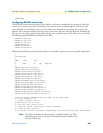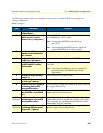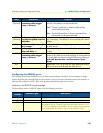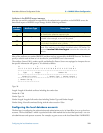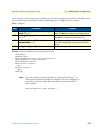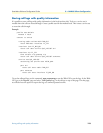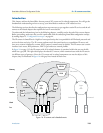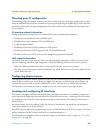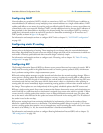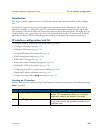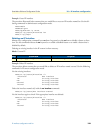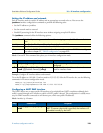
IP context overview configuration task list 116
SmartWare Software Configuration Guide 9 • IP context overview
The IP context undertakes the task of doing all IP-related transport of data and voice packets via the logical inter-
faces and available gateways. In addition, using profiles—which together with the IP context pinpoint how to
handle packets for specific services—enhances the possible field of application. Moreover, voice packets are
transported via a voice gateway to the CS context for further processing and forwarding to the PSTN.
IP context overview configuration task list
As previously described, this chapter outlines the IP context configuration. It does not give you all the details of
a configuration task, but refers you to the chapters in which you will find the full description.
• You can find all the information you need to configure an IP Interface in chapter 10, “IP interface configu-
ration” on page 120.
• You can find the information regarding network address port translation (NAPT) in chapter 11, “NAT/
NAPT configuration” on page 132.
• If you need to configure a physical port, chapter 12, “Ethernet port configuration” on page 141 or
chapter 14, “Serial port configuration” on page 170 may prove helpful.
• To set up the IP router contained in SmartWare, chapter 22, “Basic IP routing configuration” on page 235
and chapter 23, “RIP configuration” on page 242 give you the required information.
• For essential knowledge related to network security requirements, refer to chapter 24, “Access control list
configuration” on page 253.
• If your network shall provide better service to selected network traffic, chapter 13, “Link scheduler configu-
ration” on page 151 will help you to get in-depth knowledge about quality of service (QoS) management
with SmartWare.
The following sections describe the basic tasks involved in IP context configuration. Many parameters have
acceptable default values, which in most cases do not need to be explicitly configured. Hence not all of the con-
figuration tasks below are required. Depending on your application scenario, some tasks are mandatory or
might be optional. The following tasks use a bottom-up approach, starting from the ports, followed by the
interfaces up to the services running on the SmartNode. The first tasks below shall help you obtaining the nec-
essary overview, in view of the fact that there is always a risk getting lost in details before gaining a general
understanding of the whole network.
• Planning your IP configuration (see page 117)
• Configuring Ethernet and serial ports (see page 117)
• Creating and configuring IP interfaces (see page 117)
• Configuring NAPT (see page 118)
• Configuring static IP routing (see page 118)
• Configuring RIP (see page 118)
• Configuring access control lists (see page 119)
• Configuring quality of service (see page 119)



